Starting from October, ChatGPT Plus and ChatGPT Enterprise clients will be granted access to DALL-E via the API.
OpenAI has announced the release of DALL-E 3, the latest version of the text-to-image tool that uses ChatGPT to help create prompts. Users will be able to tweak their prompts – descriptions of images they want generated – through conversations with ChatGPT.
Most of the top AI image generators take their prompts in text form and use them to create artwork in various styles. One of the keys to generating the right series of images is crafting the right prompt, which has proven to be a challenge. This is the pain point DALL-E 3 seeks to address by using ChatGPT to help creators come up with better prompts.
“DALL-E 3 can translate nuanced requests into extremely detailed and accurate images,” the company said in a statement.
ChatGPT will be able to turn user inputs as short as a few words and create more detailed prompts for the Dall-E 3 model to use. Another improvement to DALL-E is the capacity to more accurately interpret prompts, creating higher-quality images than previous versions. The latest model is also better equipped to handle longer prompts and improved upon its depictions of content such as human hands or text.
Beginning in October, ChatGPT Plus and ChatGPT Enterprise clients will be granted access to DALL-E via the API. It is unclear if the company plans to release a free web tool as it has done in previous versions. OpenAI assured users that the latest version will have added safety measures such as limitations on the tool’s ability to generate violent, adult or hateful content. It will also be able to decline prompts that request images of a public figure by name or those that seek to generate images in the style of a living artist. To reassure creators, OpenAI announced that users could opt out of having some or all of their work used to train future text-to-image models. The company also claims that the latest version has new safeguards aimed at reducing algorithmic bias.
Several tech firms – including Midjourney, OpenAI, StabilityAI, BlueWillow and Alibaba’s Tongyi Wanxiang – are constantly refining their image-generating models as they compete to create the top text-to-image AI tool. The rapid emergence of AI-generated images has resulted in several legal and security concerns. A court in Washington D.C. last month ruled that AI art generated without any human input could not be copyrighted under US law. Several AI companies are faced with lawsuits from artists and creators alleging that their copyrighted work was used to train AI models.
Mercy Mutanya is a Tech enthusiast, Digital Marketer, Writer and IT Business Management Student.
She enjoys reading, writing, doing crosswords and binge-watching her favourite TV series.




